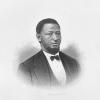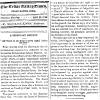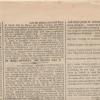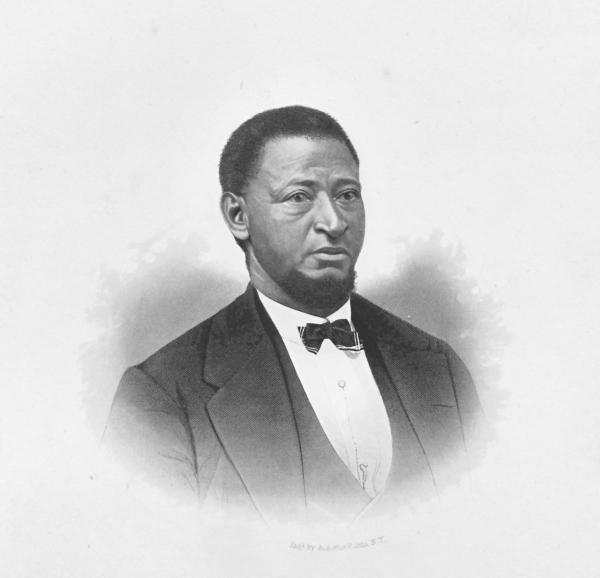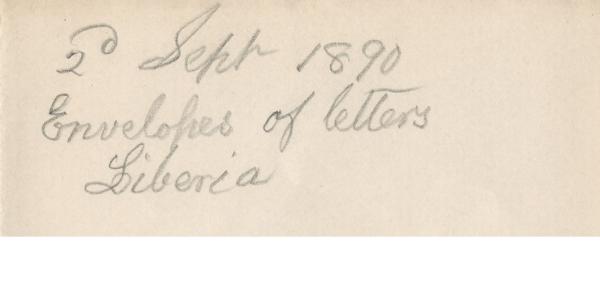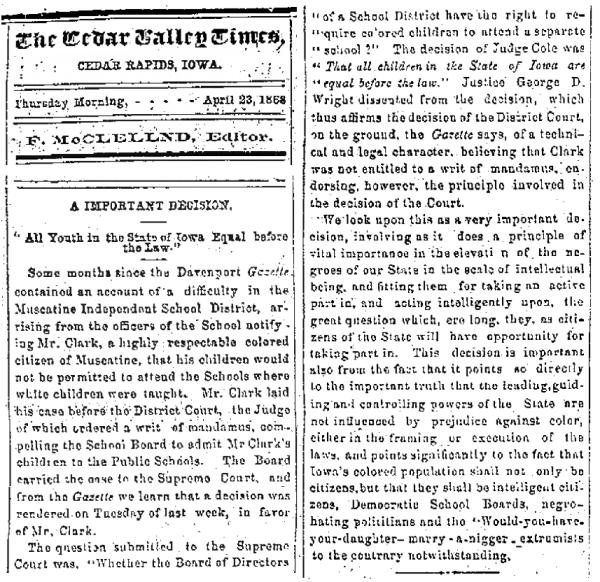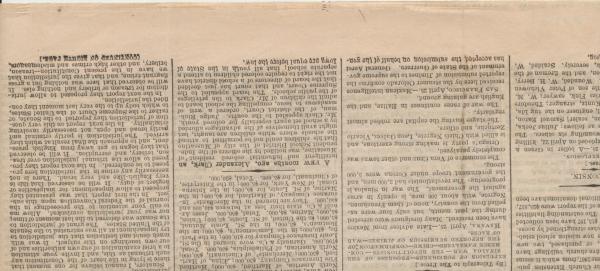Alexander Clark: A Visionary Iowan
| Grade | 9th -12th Grades | Class | U.S. History | Length of Lesson | 50 Minutes |
| Lesson Title | Alexander Clark: A Visionary Iowan |
| Unit Title | Civil Rights in Iowa |
| Unit Compelling Question | What did the fight for civil rights look like in post-Civil War Iowa? |
| Historical Context: 2018.010.014 2018.010.015 2018.010.016 2018.010.017 Clark was born free in Pennsylvania in 1826 and moved to Muscatine, Iowa from Cincinnati, Ohio, at the age of 16 to work as a barber. With a job as a barber, Clark was able to meet influential white and black males of Muscatine, helping his voice be heard. Muscatine became the largest African-American populated town in the state after many settled there after escaping the South or traveling eastward from other free states. Clark became a friend of Fredrick Douglass during the 1840s. Later he opened a business selling firewood to Mississippi River steamboats and thereby amassed considerable wealth. He also became an entrepreneur in local real estate. In 1850, he helped to organize the African Methodist Episcopal church in Muscatine and served as an officer there for 25 years. In 1865, he helped organize the Grand Lodge of Missouri, Prince Hall Masons, and served as Grand Master. Later, in 1884, he organized the Hiram Grand Lodge in Iowa and also served as Grand Master. In 1868, Clark was appointed chairman of a "colored mans" committee to rewrite the Iowa State constitution, eliminating the word "white" from the document, and thereby granting political equality to Iowans two years before the ratification of the Fifteenth Amendment to the United States Constitution. Clark was a fighter for civil rights and in 1855 signed a petition with state legislature that repealed a law that prohibited free blacks from entering the state. The repeal did not happen, however migration continued. Clark also fought for African-American right to vote and gained the right in 1868. For his children, Clark fought for equal education and sued his daughter Susan Clark's Muscatine school after she was denied entrance due to her race. Clark won his Supreme Court case and as a result, Iowa became one of the first states to integrate schools. Clark's son, Alexander Jr., became the first black graduate of the University of Iowa law school in 1879. Alexander Sr. became the second black graduate of the law school in 1884 at the age of 58. Clark was also active in Republican politics and was called "the Colored Orator of the West" for his speeches on the right of suffrage. Clark was appointed U.S. Minister to Liberia by President Harrison in 1890, which became one of the highest-ranking appointments of an African-American by a president at that point of time. Clark died while in office of a fever in 1891. |
|
| Lesson Supporting Question | |
| Lesson Overview | This lesson will explore the influential and extraordinary life of Alexander Clark, an African-American Iowan who served as ambassador to Liberia and led to fight for the first recorded example of school desegregation in the United States. Students will first be given a short introduction to the life and importance of Alexander Clark and will then analyze three primary sources documents from his life. Using these documents, they will answer several important questions in order to establish an understanding of the time in which Alexander Clark lived.
|
| Primary Sources Used |
|
| Resources Needed | https://docs.google.com/document/d/1Qk95lOZZjwlB0UDvWsQJLbtMx03FlEwo1Fy1rJqSvHI/edit https://docs.google.com/document/d/1reO2LMIlHZGEGPXcdidl_YQ384wteUxGmcMFf3JIOqU/edit https://docs.google.com/presentation/d/17-lSROoSv-H8H24LiyS_Lmx95A7aL3ekbke0WOs-hpY/edit#slide=id.p |
| Standard | |
| Lesson Target | Students will be able to understand the life of Alexander Clark and the impact he had on civil rights in Iowa.;Students will be able to analyze primary source documents to determine their historical significance.;Students will be able to analyze Iowa’s place in the broader struggle for civil rights nationwide. |
| Lesson Themes | Civil Rights, Cultural Events, Services, African American Experience |
|
| Formative Assessment (How will you use the formative assessments to monitor and inform instruction?) |
The primary source analysis worksheet will allow students to do an in-depth analysis of their assigned documents. This will give them exposure to looking at historical documents and allow them to prepare for discussion contributions., The discussion will be an informal assessment in order to gauge overall student understanding of the day’s lesson and the intended takeaways. There are some questions specific to Clark, some question relating to the documents, and some broader questions regarding connections to society both past and present. |
| Summative Assessment (How does the lesson connect to planned summative assessment(s)?) |
| Author | Travis McBride | Created | Last Edited | ||||
| Reviewer: Chad Christopher, History Education, University of Northern Iowa | |||||||
| Lesson Plan Development Notes: Teaching Methods, University of Northern Iowa, Fall 2019 | |||||||

